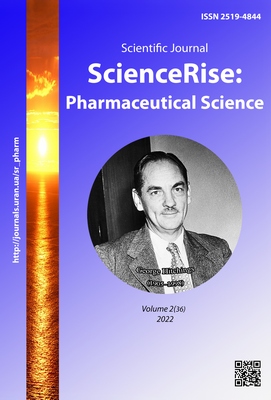Development of a unified approach to the method of identification, quantitative determination of active substances and accompanying impurities in a combined drug by HPLC method
DOI:
https://doi.org/10.15587/2519-4852.2022.255851Keywords:
liquid chromatography, acetylsalicylic acid, ascorbic acid, effervescent powder, validation, accompanying impuritiesAbstract
The aim of the work is to develop a method of identification, quantification of acetylsalicylic and ascorbic acids in the combined presence and concomitant impurities in the combined drug in the form of effervescent powder for preparation of oral solution by liquid chromatography and study of validation characteristics.
Materials and methods. ProStar liquid chromatograph with “Varian” spectrophotometric detector. Chromatographic column with a size of 150×4.6 mm, filled with aminopropylsilyl silica gel for chromatography (Supelcosil LC-NH2, “Supelco”) with a precolumn (particle size 3 μm), mobile phase - buffer solution pH 3.2 - acetonitrile P (80:20), elution mode – isocratic; mobile phase velocity – 1.2 ml/min; the detection wavelength is 240 nm.
Results. To determine acetylsalicylic and ascorbic acids by high-performance liquid chromatography with UV detection, the optimal chromatographic conditions were selected considering the influence of other active and excipients in the drug. To prove the possibility of applying the proposed technique in the subsequent analysis of the effervescent powder, its validation was performed. The obtained validation characteristics indicate that the method of quantitative determination of acetylsalicylic acid in the studied dosage form corresponds to the parameters: accuracy, precision, linearity ( =0.92≤max =1.60, d=0.19≤maxd=0.51, a=0.17 max a=2.60, r=0.9994 min r=0.9981). In the quantitative determination of ascorbic acid in the combined effervescent powder it is established that the correctness, precision, linearity are performed ( =0.86≤max =1.60, d=0.02≤max d=0.51, a=1.99 max a=2.60, r=0.9997 min r=0.9981).
Conclusions. A new method for the identification, quantification of acetylsalicylic and ascorbic acids in the combined presence and concomitant impurities in the effervescent powder using high performance liquid chromatography has been developed. The validation of the proposed method is carried out and its acceptability for use in pharmaceutical analysis is proved
References
- Anastas, P. (1999). Joe Breen-heart and soul of Green Chemistry. Green Chemistry, 1 (4), G87–G87. doi: http://doi.org/10.1039/a906793k
- McDonough, W., Braungart, M., Anastas, P. T., Zimmerman, J. B. (2003). Peer Reviewed: Applying the Principles of Green Engineering to Cradle-to-Cradle Design. Environmental Science & Technology, 37 (23), 434A–441A. doi: http://doi.org/10.1021/es0326322
- Neveselý, T., Wienhold, M., Molloy, J. J., Gilmour, R. (2021). Advances in the E → Z Isomerization of Alkenes Using Small Molecule Photocatalysts. Chemical Reviews, 122 (2), 2650–2694. doi: http://doi.org/10.1021/acs.chemrev.1c00324
- Giofrè, S., Keller, M., Lo Presti, L., Beccalli, E. M., Molteni, L. (2021). Switchable Oxidative Reactions of N-allyl-2-Aminophenols: Palladium-Catalyzed Alkoxyacyloxylation vs an Intramolecular Diels–Alder Reaction. Organic Letters, 23 (20), 7698–7702. doi: http://doi.org/10.1021/acs.orglett.1c02539
- Bringley, D. A., Roberts, B. J., Calimsiz, S., Brown, B. H., Davy, J. A., Kwong, B. et. al. (2021). Synthesis of Rovafovir Etalafenamide (Part II): Dynamic Control for Successful Scale-Up of an Oxygen-Releasing Elimination Reaction Mediated by Oxone. Organic Process Research & Development, 25 (5), 1237–1246. doi: http://doi.org/10.1021/acs.oprd.0c00439
- Korany, M. A., Mahgoub, H., Haggag, R. S., Ragab, M. A. A., Elmallah, O. A. (2017). Green chemistry: Analytical and chromatography. Journal of Liquid Chromatography & Related Technologies, 40 (16), 839–852. doi: http://doi.org/10.1080/10826076.2017.1373672
- Yabré, M., Ferey, L., Somé, I., Gaudin, K. (2018). Greening Reversed-Phase Liquid Chromatography Methods Using Alternative Solvents for Pharmaceutical Analysis. Molecules, 23 (5), 1065. doi: http://doi.org/10.3390/molecules23051065
- Pedroso, T. M., Medeiros, A. C. D., Salgado, H. R. N. (2016). RP-HPLC×HILIC chromatography for quantifying ertapenem sodium with a look at green chemistry. Talanta, 160, 745–753. doi: http://doi.org/10.1016/j.talanta.2016.08.016
- Hartman, R., Helmy, R., Al-Sayah, M., Welch, C. J. (2011). Analytical Method Volume Intensity (AMVI): A green chemistry metric for HPLC methodology in the pharmaceutical industry. Green Chemistry, 13 (4), 934–939. doi: http://doi.org/10.1039/c0gc00524j
- Rudakova, O., Gubar, S., Smielova, N., Lytkin, D., Briukhanova, T., Bezchasnyuk, E. et. al. (2021). Study of compatibility of components of a new combined drug for treatment of alcoholic intoxication and its hepatoprotective effect on a model of alcoholic liver injury. ScienceRise: Pharmaceutical Science, 6 (34), 91–100. doi: http://doi.org/10.15587/2519-4852.2021.249880
- Kowalska, M., Woźniak, M., Kijek, M., Mitrosz, P., Szakiel, J., Turek, P. (2022). Management of validation of HPLC method for determination of acetylsalicylic acid impurities in a new pharmaceutical product. Scientific Reports, 12 (1). doi: http://doi.org/10.1038/s41598-021-99269-x
- Kim, Y., Kim, M.-G. (2016). HPLC-UV method for the simultaneous determinations of ascorbic acid and dehydroascorbic acid in human plasma. Translational and Clinical Pharmacology, 24 (1), 37–42. doi: http://doi.org/10.12793/tcp.2016.24.1.37
- Doctor, N., Yang, Y. (2018). Separation and Analysis of Aspirin and Metformin HCl Using Green Subcritical Water Chromatography. Molecules, 23 (9), 2258. doi: http://doi.org/10.3390/molecules23092258
- Garmonov, S. Iu., Salakhov, I. A., Nurislamova, G. R. et. al. (2011). Opredelenie askorbinovoi kisloty, tiamina, riboflavina, nikotinamida i piridoksina v lekarstvennom preparate «Geksavit» metodom VEZhKh. Khimiko-farmatcevticheskii zhurnal, 45 (7), 48–51.
- Derzhavna Farmakopeia Ukrainy. Vol. 1 (2015). Kharkiv: Derzhavne pidpryiemstvo «Ukrainskyi naukovyi farmakopeinyi tsentr yakosti likarskykh zasobiv», 1028.
- ICH guideline Q8 (R2) on pharmaceutical development Step 5 (2017). European Medicines Agency, 24.
- ICH Topic Q 6 B Specifications: Test Procedures and Acceptance Criteria for Biotechnological/Biological Products. Step 5. Note for guidance on specifications: test procedures and acceptance criteria for biotechnological/biological products (CPMP/ICH/365/96) (2006). EMEA, 17.
Downloads
Published
How to Cite
Issue
Section
License
Copyright (c) 2022 Olha Rudakova, Svitlana Gubar, Nataliia Smielova, Maksym Yaremenko, Nataliia Bevz, Victoriya Georgiyants

This work is licensed under a Creative Commons Attribution 4.0 International License.
Our journal abides by the Creative Commons CC BY copyright rights and permissions for open access journals.








